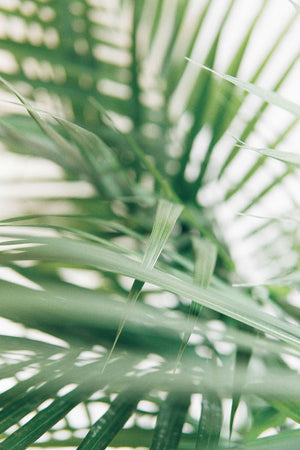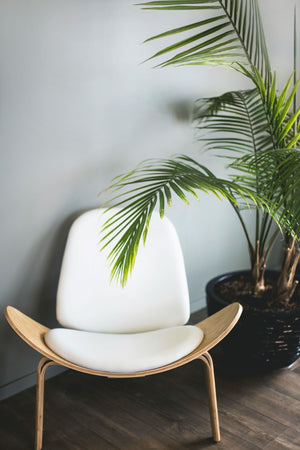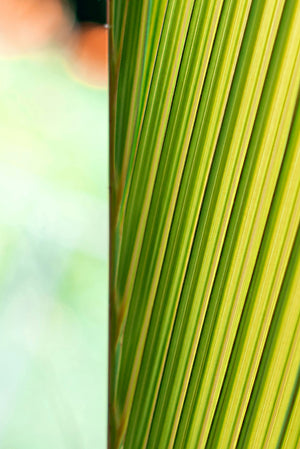The Palm Guide
Palm trees offer an unmistakable tropical ambiance, with their graceful fronds and striking silhouettes creating visual drama in both indoor and outdoor spaces. While many palms conjure images of beachside climates, a diverse range of species can be successfully grown in temperate gardens, indoor containers, or tropical landscapes, each offering unique texture and structure.

About
Palms belong to the Arecaceae family and include more than 2,500 species worldwide. These ancient plants range from towering trees to compact understory specimens and are native to tropical, subtropical, and even some arid environments. Popular species for cultivation include:
- Cycas revoluta (Sago Palm): Technically a cycad, not a true palm, this slow-growing specimen has a rugged trunk and stiff, glossy fronds.
- Beaucarnea recurvata (Ponytail Palm): A desert native with a swollen base and curly foliage, often grown as a houseplant.
- Adonidia (Christmas Palm): A compact palm popular in tropical landscapes, known for its tidy crown and ornamental red fruit.
- Bismarckia nobilis (Bismarck Palm): A striking fan palm with silvery-blue foliage and massive architectural presence.
- Hyophorbe lagenicaulis (Bottle Palm): Notable for its swollen trunk and slow growth, ideal for tropical gardens.
- Chamaedorea cataractarum (Cat Palm): A clumping, low-growing palm perfect for shaded interiors or as a tropical groundcover.
- Livistona chinensis (Chinese Fan Palm): Distinguished by its drooping, fan-shaped leaves, suitable for large containers or outdoor planting in warm climates.
- Caryota mitis (Fishtail Palm): A multi-stemmed species with jagged foliage, used as an ornamental in shaded tropical gardens.
- Ravenea rivularis (Majesty Palm): Popular as an indoor palm due to its symmetrical form and arching fronds.
- Chamaedorea elegans (Parlor Palm): A classic houseplant choice, well-suited to low light and compact spaces.
While growth rate, size, and cold tolerance vary widely, palms are typically slow to moderate growers that reward patience with elegance.

PLANTING
Success with palms begins by understanding their native habitat and mimicking those conditions as closely as possible:
- USDA Hardiness Zones: Depends on species. Chamaedorea and Cycas tolerate Zone 9; Bismarckia and Livistona prefer Zones 10–11.
- Soil: Well-draining soil is essential. Many palms thrive in sandy or loamy soil amended with compost.
- Sunlight: Varies by species. Bismarckia and Adonidia love full sun, while Chamaedorea and Caryota prefer part shade.
- Spacing: Allow room for mature spread, especially with fan palms and clumping species.
- Planting Time: Spring or early summer is ideal to allow roots to establish before cold weather.
Dig a hole twice as wide as the root ball and slightly shallower than the height of the container. Backfill with native soil mixed with organic matter, then water thoroughly.

CARE
With a few key practices, palms can thrive for years indoors or in the landscape:
- Watering: Keep soil evenly moist but not soggy. Newly planted palms need consistent moisture; established ones are more drought tolerant.
- Fertilizing: Use a palm-specific fertilizer with magnesium and manganese 2–3 times per year, especially for species like Majesty Palm or Sago Palm that are prone to deficiencies.
- Mulching: Apply mulch around the base to conserve moisture and regulate soil temperature, keeping it several inches from the trunk.
- Pruning: Remove only dead or damaged fronds. Avoid over-pruning, which can weaken the plant and expose it to sunburn or disease.
- Repotting: For indoor species like Parlor Palm or Ponytail Palm, repot every 2–3 years or when roots outgrow their container.
Indoor palms benefit from high humidity, bright indirect light, and regular misting in dry environments.

HOW TO USE
Palms bring elegance, structure, and vertical interest to a wide variety of settings:
- Indoor Décor: Use Chamaedorea elegans, Beaucarnea recurvata, or Ravenea rivularis to create a lush, tropical feel in low to bright indoor light.
- Poolside Landscaping: Fan palms like Bismarckia nobilis or Livistona chinensis provide bold form and shade in tropical outdoor settings.
- Accent Plantings: Bottle Palm and Christmas Palm work well in courtyards, patios, and entryways.
- Tropical Borders: Combine with bromeliads, ferns, crotons, or caladiums for layered plantings in tropical or subtropical zones.
- Containers: Many palms adapt well to pots, allowing them to be moved seasonally in colder climates.
Palms are excellent focal points for Mediterranean, desert, and island-style gardens.

COMMON QUESTIONS
- How fast do palm trees grow? Growth rate varies. Some, like Bismarckia and Cycas revoluta, grow slowly. Others like Adonidia or Chamaedorea are moderately fast.
- How to plant a palm tree? Choose well-draining soil, dig a wide hole, avoid planting too deep, and water thoroughly after planting.
- How to grow a palm tree? Provide species-appropriate light, regular water during establishment, and fertilizer with micronutrients. Prune minimally.
- What grows on palm trees? Many palms produce fruits, including coconuts, dates, and ornamental berries like those on Adonidia.
- Where do palm trees grow? Palms grow in tropical, subtropical, and arid regions worldwide. Some tolerate occasional frost; most prefer warmth.
- Can I have a palm tree in cold weather? Cold-hardy species like Chamaerops humilis may tolerate Zone 7–8. Most need protection below 25°F.
- How to prune a palm tree? Remove only yellowing or dead fronds close to the trunk. Avoid removing green fronds unless necessary.
- How tall can palm trees grow? Heights range from 3–6 feet indoors (Parlor Palm) to over 50 feet outdoors (Bismarckia, Livistona).
Conclusion
Palm trees add height, grace, and tropical flair to both indoor and outdoor environments. From the low-maintenance Parlor Palm to the majestic Bismarckia, there's a palm for nearly every space and climate. With proper care and placement, palms reward growers with year-round greenery and architectural beauty.
The Palm Collection
Sold Out
Sold Out
Sold Out
Sold Out
Sold Out
Sold Out






